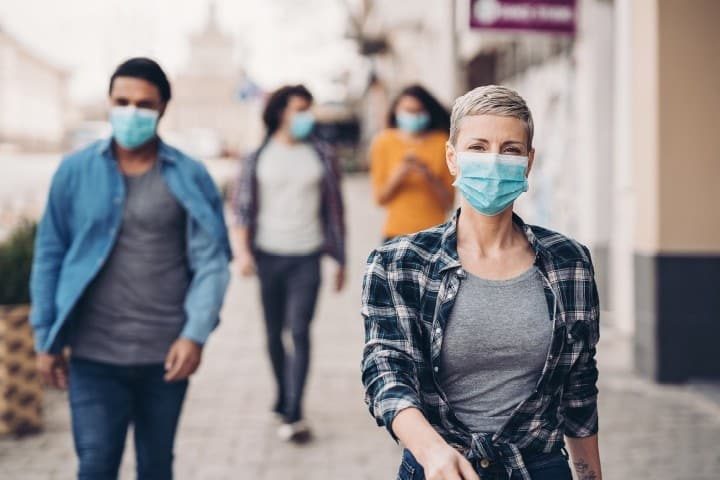
White House chief medical advisor Dr. Anthony Fauci said Sunday that people may decide to wear masks during certain seasons when respiratory illnesses are more prevalent.
“I think people have gotten used to the fact that wearing masks, clearly if you look at the data it diminishes respiratory diseases, we’ve had practically a non-existent flu season this year merely because people were doing the kinds of public health things that were directed predominantly against Covid-19,” Fauci said during an interview on NBC’s Meet the Press.
“So it is conceivable that as we go on a year or two or more from now that during certain seasonal periods when you have respiratory borne viruses like the flu, people might actually elect to wear masks to diminish the likelihood that you’ll spread these respiratory borne diseases,” he added.
This year’s flu season was conspicuously “light,” with fewer than 2,000 confirmed cases in the U.S. this season, according to the CDC, while there were around 38 million flu cases during the 2019-2020 season, the agency said.
Fauci and many of his colleagues praise mask wearing, social distancing, and lockdowns as reasons for low spread of respiratory viruses, including influenza, which causes flu. “It’s been an amazing year,” said Dr. John Swartzberg, professor emeritus of infectious diseases at the University of California-Berkeley, “In all my years of being a flu watcher … I’ve never seen anything like this.”
Some doctors believe the drop in flu cases can be explained by the natural competition between viruses. The mere presence of the coronavirus may have played a role in suppressing flu cases, believes Dr. Richard Webby, a virologist at St. Jude Children’s Research Hospital in Memphis. There is usually just one dominant respiratory virus in a population at a given time: “One tends to keep the other out.” In other words, the flu season was non-existent not because of mask-wearing, bur because influenza virus has lost a competition to coronavirus.
Of course, some have speculated that many flu cases were lumped in with COVID-19 cases and labeled as COVID-19, making the COVID case count appear incredibly high and the “regular flu” case count appear incredibly low.
At any rate, flu cases allegedly dropped — but at what cost? Children lost a year of school, stuck in subpar virtual learning; the economy lost billions of dollars and millions of livelihoods; rates of child abuse, divorce, untreated diseases, and mortality rates from heart diseases, strokes, cancers, and diabetes are all up. Fauci’s politically motivated recommendations burned the village in order to save it, and now he seems to invite us to celebrate it.
Concerning masks alone, there is ample evidence that they are not just ineffective at containing the spread of respiratory viruses, but may actually compromise the health of wearers.
Top Oxford scientists have warned there is a “troubling lack of evidence” that face masks prevent the spread of COVID-19 and other respiratory infections, since there have only been three “real life” studies comparing mask-wearers to non-mask-wearers — one in Guinea-Bissau, one in India, and one in Denmark. All have shown masks to have no benefit in preventing the spread of the disease. The experts added, “Now we have properly rigorous scientific research we can rely on, the evidence shows wearing masks in the community does not significantly reduce the rates of infection.”
In the early days of the COVID-19 outbreak, Dr. Fauci himself told us that masks probably weren’t going to help protect us from the Wuhan virus. Joe Biden’s COVID-19 advisor, Dr. Michael Osterholm, similarly agreed that wearing masks is “largely nonsense” and that “trying to stop the flu is like trying to stop the wind.”
These expert opinions were based on a meta-analysis of multiple studies about masks on the Centers for Disease Control and Prevention’s (CDC’s) website. It concluded, “We did not find evidence that surgical-type face masks are effective in reducing laboratory-confirmed influenza transmission, either when worn by infected persons (source control) or by persons in the general community to reduce their susceptibility.” What made CDC reconsider its own conclusions? It is argued that the most recent pro-mask studies are deeply flawed.
At the same time, there are proven long-term side effects of mask-wearing, such as a weakened immune system, development of chronic respiratory conditions, dermatitis, and headaches.
Fauci’s remarks about mask-wearing correlates with the attitude of nearly half of Americans (49 percent), who say they still will be wearing masks even after vaccination, and even after the “war” on COVID is won, according to a Rasmussen poll. On how long mask mandates should be expected, 58 percent of respondents said they expect to be wearing masks in public for at least the next six months, while 25 percent believe they will be required for 18 months or longer. Some (15 percent), however, said they expect mask mandates to be in place for years to come or “indefinitely.”
To date, 25 state governments currently require people to wear face coverings in most public settings. The District of Columbia and Puerto Rico also have mask orders in place, while 14 states that had mask orders have lifted them, 11 by gubernatorial order (Alabama, Arkansas, Indiana, Iowa, Louisiana, Mississippi, Montana, New Hampshire, North Dakota, Texas, and Wyoming), two by legislative action (Kansas and Utah), and one by court order (Wisconsin).




